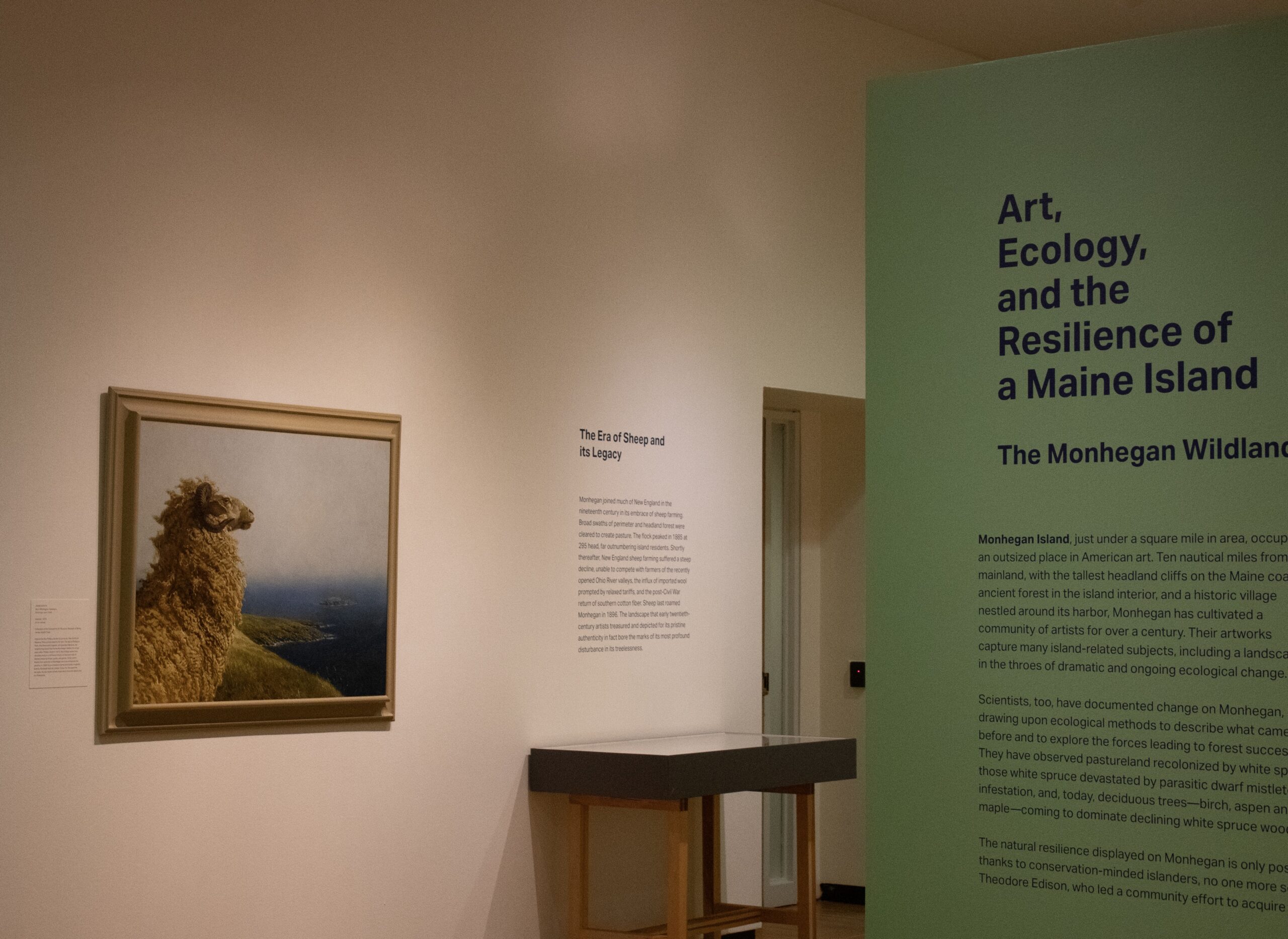Capturing art and the natural world on Monhegan Island
January 24, 2025
 Janet Briggs
Janet BriggsAn island ten miles off the coast of Maine with roughly 50 year-round residents represents centuries of ecological development in both land and art.
“Art, Ecology and the Resilience of a Maine Island: The Monhegan Wildlands” opened at the Bowdoin College Museum of Art (BCMA) on December 12. This exhibit, co-curated by Professor in the Natural Sciences Barry Logan, BCMA Co-Director Frank Goodyear and Director of the Monhegan Museum of Art and History Jennifer Pye, highlights how the ecological study of Monhegan complements the landscape art of the island.
Three-fourths of Monhegan’s land is conserved and features both ancient-growth forests and secondary-growth forests after part of the island was cleared in the 19th century for pasture land. The duality of land use over the years has created an evolving ecological landscape within the contained space.
“Some of America’s most renowned landscape painters earned their reputation out there and others have been painting that landscape through that period, and through that period, it has been changing from an ecological standpoint,” Logan said.
Thus, the landscapes coming out of Monhegan in the early 20th century reflect greater pasture land while those later in the 20th century focus on the growing vegetation, which parallels the ecological history and Logan’s research on the island.
As you enter the exhibition, bird and fishing noises from the island fill the space, and maps created by a Monhegan-connected cartographer show the island as it was in 1890 and another of contemporary Monhegan.
There is work from artists around Maine who either reside on Monhegan throughout the year or were commissioned for the exhibit. In particular, Barbara Putnam created prints inspired by a study on the consequences of parasitic dwarf mistletoe infection on white spruces on Monhegan. The BCMA commissioned Accra Shepp, a New York-based photographer, to photograph scenes from Monhegan that spliced together photos taken on a vintage film camera.
Additionally, the accompanying exhibition book includes seven essays from various people either involved directly in the historical and artistic community of Monhegan or those with an environmental and ecological understanding of the island. Associate Professor of History and Environmental Studies Matthew Klingle is among them.
“One of the things that pleases me most about it is the richness of the voices that are in there, and it’s not just ‘Hey it’s fun to have you bolted on the side of this thing.’ Everybody’s contributions shaped its direction at the end of the day,” Logan said.
As part of the opening of the exhibit, Sant Director of the Smithsonian Institution’s National Museum of Natural History Kirk Johnson came to speak about the development of paleoart. Through the work of paleontology and excavation, Johnson argues that people can reconstruct landscapes and wildlife that have long since been buried.
Johnson aired his frustration with contemporary art that depicts prehistoric environments inaccurately, what he called “monkey puzzle tree and parking lot” depictions. Often, the focus of this art is on dinosaurs or other large species, which he felt undercut the work of paleobotanists like himself that could tell a lot about a place’s ecological makeup through fossilized plants.
Much of his early work centered on areas around Colorado, where large amounts of fossilized plants were discovered that challenged the previous hypothesis of more arid landscapes, instead revealing the variety of different landscapes that changed drastically over time.
“So we set out with a question: Could we actually do a really accurate reconstruction of an ancient landscape?” Johnson said. “We dug literally tens of thousands of fossil leaves…. And slowly this cretaceous world started coming to focus, and we had one rule and one rule only, which was we could only put in the painting what we found in the outback. We constrained ourselves to a time and a place to build that world.”
This was the basis for much of the exhibitions that are in the Museum of Natural History today, and inspired the “Deep Time” exhibit that is on display in the BCMA. Johnson described how each of these depictions is a hypothesis of what an environment looks like and are constantly evolving.
“Renderings of the past are a form of science because it’s a hypothesis, and if you look at science, it just gets better and better and better,” Johnson said. “And I would just look at these images as dated elements of the scientific process. To that end, you don’t usually go look at the date stamp on your paleoart, but that’s probably a good thing to do.”
“Art, Ecology and the Resilience of a Maine Island: The Monhegan Wildlands” will be on display in the BCMA until June 1, and the BCMA hosted speakers to discuss the exhibit today. These included Executive Director of the Osher Map Library and Smith Center for Cartographic Education Libby Bischof, Chair of Monhegan Associates’ Land Committee Doug Boynton and Directory Emeritus of Harvard Forest David Foster.

Comments
Before submitting a comment, please review our comment policy. Some key points from the policy: